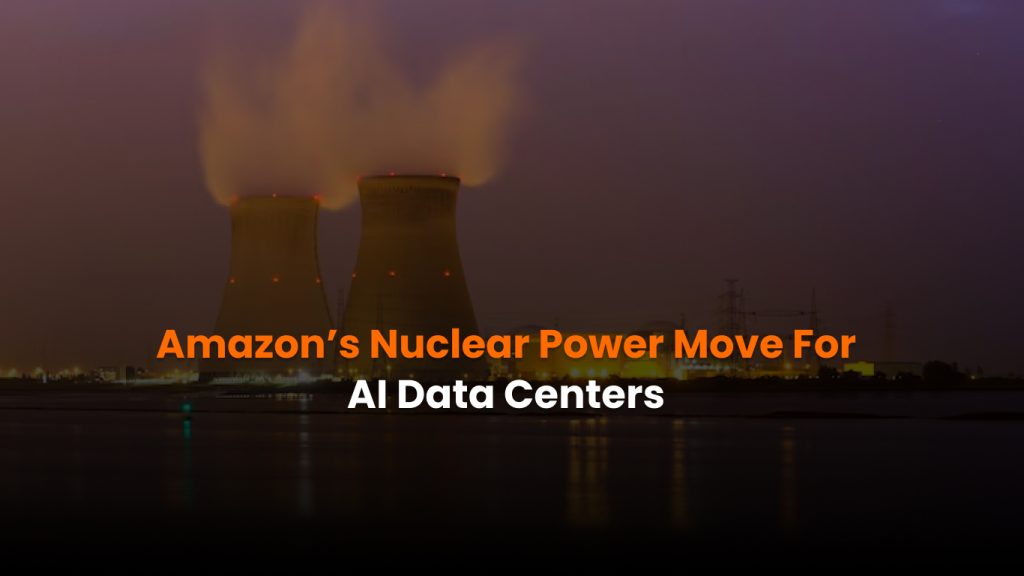Introduction: A Landmark Deal in Data Center Energy
Amazon Web Services (AWS) has struck a groundbreaking deal with Talen Energy to power its data centers using nuclear energy. Talen will supply up to 1,920 MW of carbon‑free electricity from its Susquehanna nuclear plant in Pennsylvania. This long‑term agreement runs through 2042 and will fuel Amazon’s growing AI and cloud computing operations with steady, emissions‑free power. In addition to this, Amazon is investing $20 billion in new data center campuses in Pennsylvania, marking the largest private investment in the state’s history. The company is also exploring Small Modular Reactors (SMRs) with Talen for future capacity.
This deal signals a major shift in how tech giants source energy for their power‑hungry data centers. After relying heavily on solar, wind, and other renewables, companies are now incorporating nuclear power to meet surging electricity demand driven by AI workloads. This shift reflects broader energy strategies across the U.S. tech sector—and it carries significant implications for the solar industry.
The Rising Energy Demands of AI Infrastructure
AI workloads are extremely power-intensive. Training and running advanced AI models like ChatGPT requires vast computing power, which draws significant electricity for both servers and cooling. For example, each AI query can consume nearly ten times more power than a standard web search. Annual electricity consumption for models like ChatGPT alone is estimated in the hundreds of gigawatt‑hours.
As AI capabilities expand, global data center electricity consumption is projected to more than double by 2030. In the U.S., data centers are expected to account for nearly half of all new electricity demand growth through the end of the decade. This unprecedented demand is now exceeding that of traditional industrial sectors like aluminum and cement production.
To put this in perspective, U.S. data centers consumed approximately 176 TWh of electricity in 2023—more than double their usage in 2018. Projections show usage may reach between 325 and 580 TWh by 2028. Tech companies are facing mounting pressure to secure reliable, low-carbon power sources to sustain this growth.
Big Tech Turns to Nuclear for Stability
Facing this surge in demand, major cloud providers are looking beyond traditional renewables. Nuclear energy has emerged as a preferred solution due to its ability to deliver steady, high‑capacity power around the clock.
Select AI‑Focused Data Center Energy Deals (U.S.): Nuclear and Beyond
| Company & Location | Energy Source (Capacity) | Term / Timeline | Purpose |
| Amazon AWS – Pennsylvania | Nuclear – Susquehanna plant (up to 1,920 MW) | 2025–2042 (PPA) | Powers AWS AI data centers; exploring SMRs on-site; paired with $20 B investment |
| Meta Platforms – Illinois | Nuclear – Clinton reactor (~1,100 MW) | 20‑year PPA (through ~2045) | Supplies Meta’s data centers; extends reactor lifespan |
| Microsoft – PA (Azure) | Nuclear – Three Mile Island (~800 MW) | 20‑year restart by ~2028 | Powers Azure AI cloud; supports reactor restart and nuclear R&D |
| Google – various US sites | Advanced SMRs (~600 MW each, modular) | Planning for 2030s rollout | Prepares sites for future nuclear-powered Google Cloud |
| Switch, Inc. – US campuses | SMRs – Oklo microreactors (up to 12 GW total) | Framework through 2044 | Deploys modular reactors supplementing renewables |
| Oracle & Equinix | SMRs / Nuclear | Planning stage | Exploring on-site nuclear-powered cloud campuses |
This table highlights the common theme: a strategic pivot toward reliable, carbon-free baseload energy. While solar and wind remain part of the equation, nuclear offers unparalleled uptime and predictability—critical for AI-driven data centers.
The Enduring Role of Renewables
Despite the rise of nuclear, renewables—particularly solar—remain central to clean energy strategies. Tech companies have become the world’s largest buyers of solar and wind power, driving unprecedented growth in utility-scale projects.
In recent years, corporate clean energy procurement has exploded, with data center operators leading the charge. Amazon remains the single largest corporate buyer of renewables, powering the equivalent of over eight million homes. Microsoft, Google, and Meta have all committed to 100% clean energy targets by 2030 or sooner.
However, the intermittent nature of solar and wind creates reliability gaps. This has led to a surge in hybrid projects that combine renewables with battery energy storage systems (BESS). By pairing solar with storage, companies can smooth out energy delivery and maintain uptime even during nights or cloudy days.
At Sunhub, we offer a broad selection of solar panels, inverters, and battery systems that can be integrated into such solutions. Our marketplace supports the growing need for scalable and reliable solar infrastructure.
The Smart Energy Mix: Solar, Storage & Baseload Power
Modern energy strategies now favor blended approaches. Companies are combining geographically diverse solar and wind contracts to balance generation. They’re also leveraging hydroelectric power and exploring newer technologies like green hydrogen for backup generation.
While nearly all data centers still draw power from the grid, the trend is toward minimizing fossil fuel dependency. Many tech firms are transitioning to greener solutions, opting for solar plus storage systems that offer a reliable and cleaner path to sustainability.
Solar developers are also becoming more innovative. They structure 24/7 carbon-free energy contracts, guaranteeing delivery of clean power every hour of the day—a mix of solar, wind, batteries, and sometimes nuclear or geothermal energy.
What This Means for the Solar Industry
The growing interest in nuclear does not spell doom for solar. Instead, it underscores the need for solar to evolve. The rise of solar-plus-storage systems is a direct response to the reliability challenge. These hybrid models allow solar to act more like a baseload power source, delivering consistent output day and night.
While nuclear may handle a portion of the base load, the overall electricity demand from AI and data centers is growing so rapidly that renewables will continue to dominate. Solar developers who adapt to new expectations—like firm delivery and integrated storage—will remain competitive.
In fact, data centers may open new doors for solar. Co-locating PV systems next to campuses can bypass grid bottlenecks. Flexible AI workloads can be timed to sunlight hours, maximizing cheap daytime solar energy.
Challenges remain, particularly for standalone solar projects lacking storage. Regulators may also prioritize nuclear-enabled grid stability over new transmission lines. But with innovation and adaptability, solar will thrive.
For Sunhub, this moment is a call to lead. We’re committed to empowering energy solutions that meet today’s challenges and tomorrow’s demands. With scalable solar systems, intelligent inverters, and energy storage, our platform connects buyers and suppliers in building a cleaner, smarter energy future.
Conclusion: The Road Ahead
Amazon’s nuclear deal with Talen Energy represents more than a contract—it marks a fundamental shift in digital era energy priorities. In the age of AI, energy strategy has become business strategy.
The future of data center power will be multi-dimensional: combining solar, wind, hydro, storage, and now, nuclear. The challenge lies in integrating these technologies into resilient, flexible systems that support both reliability and sustainability.
For the solar sector, the opportunity is enormous. As AI and cloud computing energy demands continue to rise, solar will remain central. With the right tools and partnerships, the solar industry—and platforms like Sunhub—can not only coexist with nuclear but lead the clean energy revolution.




